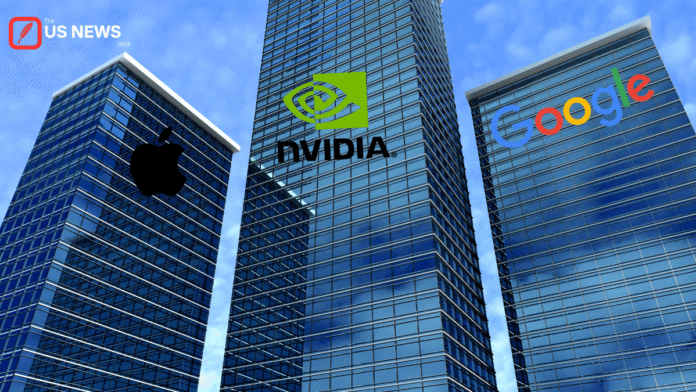The artificial intelligence boom has fueled a race unlike any the technology sector has seen in decades. While much of the conversation centers on chatbots and generative AI tools, the real battlefield lies deeper — in the silicon powering them. Apple, Nvidia, and Google are engaged in a high-stakes contest over the future of AI chips, a hardware race that could redefine global computing and reshape trillion-dollar industries.
Why AI Chips Matter More Than Software Hype
Software breakthroughs may grab headlines, but every AI model relies on specialized chips to function. Traditional CPUs, designed for general tasks, cannot keep up with the massive parallel computations required for training and deploying large AI systems.
This is where GPUs, TPUs, and custom silicon step in:
- Nvidia’s GPUs dominate the AI market, powering everything from research labs to cloud data centers.
- Google’s TPUs (Tensor Processing Units) give it an in-house advantage for scaling AI products like Google Search and YouTube recommendations.
- Apple’s Neural Engine inside iPhones and Macs ensures AI features run locally, preserving both speed and user privacy.
The battle is not just about faster chips — it’s about control over the AI ecosystem. Whoever leads in hardware sets the terms for the next decade of software innovation.
Nvidia: The Unchallenged King — For Now
Nvidia remains the backbone of today’s AI infrastructure. Its GPUs, particularly the H100 and upcoming B200 series, are the gold standard for training massive models like OpenAI’s GPT and Anthropic’s Claude.
However, this dominance has created bottlenecks:
- Global shortages have driven up chip prices, sometimes costing tens of thousands of dollars per unit.
- Export restrictions tied to U.S.–China tensions have complicated Nvidia’s supply chain.
- Competitors worry about becoming too dependent on a single provider.
These vulnerabilities open the door for Apple and Google to carve out space in a market Nvidia currently controls.
Google: Betting Big on Vertical Integration
Google’s AI ambitions hinge on tight control of its stack. With its Tensor Processing Units (TPUs), Google avoids relying solely on Nvidia and builds chips optimized for its own software.
- Cloud Advantage: Google Cloud customers gain access to TPUs, creating a lock-in effect that boosts adoption of Google’s AI services.
- Research Edge: In-house AI labs like DeepMind have a direct line to hardware engineers, accelerating breakthroughs.
- Cost Efficiency: Owning hardware reduces reliance on expensive third-party chips.
The strategy is risky — chip design and manufacturing are capital-intensive — but if it succeeds, Google could control not just the software layer of AI but the physical foundations as well.
Apple: Quietly Preparing a Hardware Coup
Unlike Nvidia and Google, Apple’s AI hardware strategy has been quieter but no less ambitious. Its Neural Engine, built into iPhones and Macs, positions Apple uniquely in the consumer market.
- On-Device AI: Features like Siri improvements, photo recognition, and predictive text rely on localized AI computation.
- Privacy First: Running AI on-device aligns with Apple’s longstanding commitment to user privacy.
- AR/VR Future: With the launch of the Apple Vision Pro, Apple is betting that AI chips will be essential for immersive, real-time computing.
While Apple has not announced data center-scale AI chips yet, analysts suggest the company could extend its M-series chip designs into enterprise-grade AI hardware. If so, Apple would bring its famed ecosystem approach into direct competition with Nvidia and Google.
The Global Stakes: Why This Race Matters
The AI chip race is not merely a corporate rivalry. It has broad economic and geopolitical consequences:
- Supply Chains: AI chips rely on advanced fabrication plants, mostly controlled by TSMC in Taiwan, making the industry vulnerable to regional instability.
- National Security: U.S. policymakers see AI hardware leadership as critical to maintaining a technological edge over China.
- Innovation Cycle: Breakthroughs in chip performance directly impact the pace of AI research, healthcare innovations, autonomous vehicles, and more.
This is why Wall Street closely tracks chipmakers alongside software firms. The hardware defines the pace of AI progress.
Challenges Ahead for Each Player
- Nvidia must address shortages and diversify beyond data centers.
- Google faces investor skepticism about the profitability of its custom silicon strategy.
- Apple risks falling behind in large-scale AI training if it limits itself to consumer devices.
The outcome may not crown a single winner. Instead, we could see a fragmented AI ecosystem, where Nvidia dominates enterprise AI, Google controls the cloud, and Apple rules the consumer market.
Conclusion
The future of AI won’t be decided by chatbots alone. The real clash is in the labs and foundries where AI chips are designed and built. Apple, Nvidia, and Google are racing to define that future, each betting that their hardware vision will shape the next decade of global technology.
This hardware race is the silent force driving the AI revolution — one that will ultimately determine how quickly, safely, and equitably AI reshapes society.




